Links to external sources may no longer work as intended. The content may not represent the latest thinking in this area or the Society’s current position on the topic.
The origins of numerical abilities

Scientific discussion meeting organised by Professor Brian Butterworth FBA, Professor Charles Gallistel and Professor Giorgio Vallortigara.
Humans possess numerical abilities and have invented cultural tools to use them efficiently; but many other creatures, from insects to primates, have in the past decade been found to possess numerical abilities, possibly descended from a common ancestral form. Therefore, when we acquire numerical competence, for example in school, we build upon a specific inherited cognitive foundation.
Speaker abstracts and biographies are available below. Recorded audio of the presentations are also available below. A publication of this meeting is now available in Philosophical Transactions of the Royal Society Biological Sciences.
This meeting was followed by a related satellite meeting 'The origins of numerical abilities: the future' at the Royal Society at Chicheley Hall on 22-23 February 2017.
Enquiries: Contact the Scientific Programmes team
Organisers
Schedule
Chair

Professor Brian Butterworth FBA, University College London, UK

Professor Brian Butterworth FBA, University College London, UK
Brian Butterworth is in the Institute of Cognitive Neuroscience at University College London, where he is currently working on the neuroscience and the genetics of mathematical abilities and disabilities. He led two European networks, Neuromath and Numbra, that promoted multidisciplinary research on mathematical cognition. At UCL, he created the first master’s degree in cognitive neuroscience, and founded, and was first chair of, the Centre for Educational Neuroscience. He holds professorial positions at National Chengchi University, Taiwan, and at Melbourne University, Australia. He was elected Fellow of the British Psychological Society in 1993, and Fellow of the British Academy in 2002.
His popular science book, The Mathematical Brain (1999) was a best seller. The Dyscalculia Screener (2003) revolutionized the identification of this specific learning disability. His latest book, co-edited with Denis Mareschal and Andrew Tolmie, Educational Neuroscience, was published by Wiley in 2013.
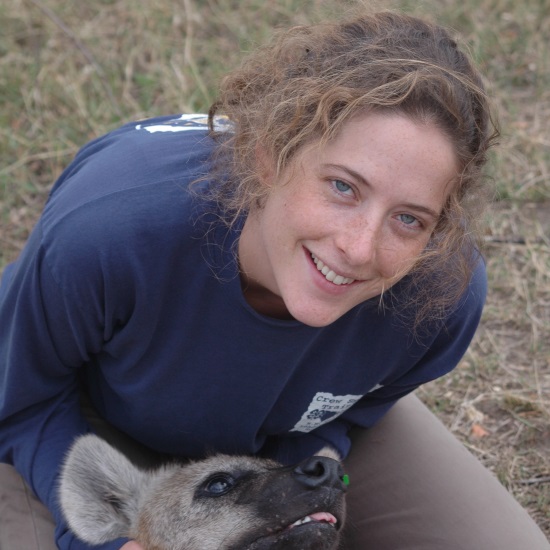
Professor Sarah Benson-Amram, University of Wyoming, USA

Professor Sarah Benson-Amram, University of Wyoming, USA
Sarah Benson-Amram is the Director of the Animal Behavior and Cognition Laboratory and an assistant professor in the Department of Zoology and Physiology and in the Program in Ecology at the University of Wyoming, USA. Sarah is interested in understanding the evolution of complex cognitive abilities in animals and in investigating what animals know about their social and ecological environments. Additionally, she inquires how animals use this knowledge and their ability to learn about their environments in adaptive ways. Sarah’s research has been published in top international journals, such as the Proceedings of the National Academy of Sciences and the Proceedings of the Royal Society: B. Articles about her work have appeared in many news publications, including: the New York Times, The New Scientist, the BBC, National Public Radio, and Nature News. Sarah earned her PhD from Michigan State University in the USA and conducted her postdoctoral research at the University of St. Andrews in Scotland, UK.
| 09:05 - 09:50 |
How does the brain code quantity?
The representation of numerosity must be embedded in a system for representing both discrete and continuous quantities. The most basic question then is the coding question: how does the brain encode a quantity? Neuroscience has nothing to offer in the way of an answer. Computer science does. The code is probably not unary, which rules out analog codes, like rate codes, because it must support the implementation of addition and multiplication over many orders of magnitude. Also analog codes have reading noise; the build up of purely computational error makes dead reckoning impossible. The representation must be able to approximate a huge range of the computable numbers (negative, positive, |n|>> 1 and |n|<<1). Twos-complement fixed point with settable offset (bias) and slope (scale) and a 2-bit to 8-bit integer portion has much to recommend it: 1) it obeys Weber’s Law. 2) It is the most computationally efficient of the known codes (least amount of hardware and least energy use). 3) It is particularly advised for Archimedean computations like dead reckoning, where a great many additions of small quantities may produce a quantity orders of magnitude larger. 4) It converts subtraction to addition. 5) The bit flipping that is the key to this conversion has a natural chemical realisation. 6) Division and multiplication by 2 are particularly simple and known to be psychologically easy and fast. 7) It can produce an exact code for large integers. 8) It solves the exact equality problem. 
Professor Charles Gallistel, Rutgers University, USA

Professor Charles Gallistel, Rutgers University, USAC.R. Gallistel is Professor of Psychology, Emeritus and formerly Co-Director of the Rutgers Center for Cognitive Science at Rutgers. He taught previously at the University of Pennsylvania (1966-1989) and UCLA (1989-2000). He received his BA from Stanford in 1963 and his PhD in Psychology from Yale University in 1966. His research currently focuses on the development of quantitative, highly automated behavioural tests for memory malfunction in genetically manipulated mice, with the long-term goal of using genetic methods to discover the molecular, cellular and systems’ mechanisms underlying the foundational mechanisms of cognition. Other research interests are spatio-temporal learning, the theory of associative learning, the theory of action, non-verbal arithmetic in humans and non-human animals, matching behaviour, the perception of probability and electrical self-stimulation of the brain in the rat. He is a member of the American Academy of Arts and Sciences and the National Academy of Sciences. He has written several influential books. |
|
|---|---|---|
| 09:50 - 10:35 |
Numerical assessment in the wild: insights from social carnivores and other mammals
Playback experiments have proven to be a useful tool to investigate the extent to which wild animals understand numerical concepts and the factors that play into their decisions to respond to different numbers of vocalising conspecifics. Professor Benson-Amram will review a series of playback experiments conducted with wild social carnivores and other mammals, including African lions, spotted hyenas, and chimpanzees, which demonstrate that these animals can assess the number of conspecifics calling and respond based on numerical advantage. Additionally, she will discuss the key role that individual discrimination and cross-modal recognition can play in the ability of animals to assess the number of conspecifics vocalising nearby. For example, a listener hearing three vocalisations would benefit from being able to assess whether the vocalisations were emitted by the same individual or three different ones, and whether the identity of the callers match individuals they have recently seen in the area. Because the costs and benefits associated with approaching conspecifics change depending on the callers’ age, sex, and relatedness, listeners will likely adjust the level of their behavioural response to playback experiments where the identity of the callers change even when the number of callers is held constant. The listener’s sex, age, social rank and social system will also help determine their behavioural response to varying number of competitors. Finally, Professor Benson-Amram will discuss the implications of these findings for understanding how carnivores and other animals may have evolved a concept of ‘one’. 
Professor Sarah Benson-Amram, University of Wyoming, USA

Professor Sarah Benson-Amram, University of Wyoming, USASarah Benson-Amram is the Director of the Animal Behavior and Cognition Laboratory and an assistant professor in the Department of Zoology and Physiology and in the Program in Ecology at the University of Wyoming, USA. Sarah is interested in understanding the evolution of complex cognitive abilities in animals and in investigating what animals know about their social and ecological environments. Additionally, she inquires how animals use this knowledge and their ability to learn about their environments in adaptive ways. Sarah’s research has been published in top international journals, such as the Proceedings of the National Academy of Sciences and the Proceedings of the Royal Society: B. Articles about her work have appeared in many news publications, including: the New York Times, The New Scientist, the BBC, National Public Radio, and Nature News. Sarah earned her PhD from Michigan State University in the USA and conducted her postdoctoral research at the University of St. Andrews in Scotland, UK. |
|
| 10:35 - 11:00 | Coffee | |
| 11:00 - 11:45 |
At the roots of numerical cognition: insights from the day-old domestic chick (Gallus gallus)
The ability to represent number and to use numerical concepts, such as real numbers, logarithms, and square roots, is a prerogative of a subset of human beings who have received specific mathematical instruction. In the last few decades, however, it has been demonstrated that non-verbal numerical abilities (i.e., those calculations that can be solved in the absence of words) are widespread within the animal Kingdom. To investigate the ontogenetic origins of numerical knowledge Dr Rugani used the domestic chick (Gallus gallus) as animal model. Unlike previous studies on adult animals, this model can be tested very early in life, allowing a precise control of sensory experience. Dr Rugani will discuss evidence revealing that day-old domestic chicks can: (i) discriminate between different numbers of artificial social companions (i.e., objects they were exposed to soon after hatching); (ii) solve rudimentary arithmetic calculations, such as 1+1+1 vs. 1+1; and (iii) use ordinal information, identifying a target element, (e.g., the 4th), in a series of identical elements, on the basis of its numerical position in the series. These studies suggest that non-verbal numerical comprehension can be observed in animals in the absence of (or with very reduced) experience, indicating that numerical competences may not have emerged ‘de novo’ in our species together with language, but that they could be based on an evolutionary-ancient precursor system. 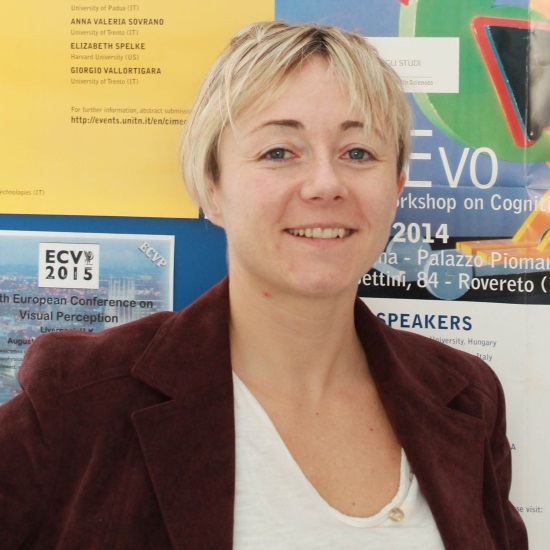
Dr Rosa Rugani, University of Padova, Italy

Dr Rosa Rugani, University of Padova, ItalyRosa Rugani is a fellow at the Department of General Psychology at the University of Padova. Her research focus is the biological basis of cognitive processes. She was visiting researcher at the Center for Avian Cognition of the Saskatchewan University in Canada and at the Center for Cognitive Neuroscience of the Duke University in Durham, North Carolina (USA). Her research has been published in prestigious scientific journals and her work has attracted media attention internationally because of her notable and original contribution to the advancement of our knowledge on the biological basis and evolution of animal mathematical cognition. |
|
| 11:45 - 12:30 |
The primacy of numerical information
The ability to use numbers is one of the most complex cognitive abilities that humans possess and is often held up as a defining feature of the human mind. Alongside the uniquely human symbolic system for representing number we possess an approximate number system (ANS) that is evolutionarily ancient and developmentally conservative. In this talk Professor Brannon will illustrate the signatures of the ANS with experimental data from human babies and nonhuman primates. She will describe behavioural and neurobiological data that demonstrates how the human and nonhuman primate mind privileges numerical information over other types of quantitative information. She will argue that this numerical privilege implicates the biological importance of number in our evolutionary history. 
Professor Elizabeth Brannon, University of Pennsylvania, USA

Professor Elizabeth Brannon, University of Pennsylvania, USADr Elizabeth M. Brannon graduated Summa Cum Laude from The University of Pennsylvania, where she received her BA in Physical Anthropology in 1992. In 1994, she received a Masters degree in Anthropology from Columbia where she worked with Dr Marina Cords. In 2000, she completed a PhD in Psychology in the laboratory of Dr Herb Terrace. Dr Brannon was faculty at Duke University from 2000-2015 where she served as Director of Graduate Studies for the Cognitive Neuroscience Admitting Program and Head of the Developmental Training Area. She is now a Professor of Psychology at The University of Pennsylvania. Dr Brannon has received numerous academic awards and honours including the Young Investigator Award from The Society for Experimental Psychology, a CAREER award from the National Science Foundation, a Merck Scholar Award, and a James McDonnell Scholar Award. She served on the editorial board of Psychological Science, Cognition, and Infancy, served as associate editor for Developmental Science and is currently serving as an associate editor for Open Mind. Dr Brannon’s research is currently funded by The National Science Foundation and The National Institutes of Health. Dr Brannon teaches courses on cognitive development and comparative psychology and her research probes the developmental and evolutionary building blocks of human mathematical knowledge. |
|
| 12:30 - 13:30 | Lunch | |
| 13:30 - 14:15 |
Numerical abilities in fish
While there is a well established tradition of studying numerical abilities in mammals and birds, it is only in the last decade that some studies have proposed that teleost fish possess similar capacities. There is substantial evidence showing that fish integrate numerical information and continuous quantities (such as cumulative surface area or convex hull) when assessing which group of fish or objects is larger/smaller. Typically, their performance is more accurate when both pieces of information are simultaneously available, although different fish species were also shown to use pure numerical information when prevented from using continuous quantities. The ability to discriminate small numbers of social companions seems to be already displayed at birth while large number discrimination develops later as a consequence of maturation and experience. The similarities among species (i.e., Gambusia holbrooki, Poecilia reticulata, Danio rerio, Pterophyllum scalare and Xenotoca eiseni) appear greater than the differences, and in general, the numerical capacities of fish partially match those reported in mammals and birds, raising the intriguing idea that our non-symbolic numerical abilities are more ancient than previously thought and date back at least as far as the divergence between fish and land vertebrates. Dr Agrillo will summarise the current state of art in the literature, focusing on three main topics: the relation between discrete (numerical) and continuous quantities, the ontogeny of numerical abilities in fish and the comparison of numerical abilities of fish and other vertebrates. 
Dr Christian Agrillo, University of Padova, Italy

Dr Christian Agrillo, University of Padova, ItalyChristian Agrillo is assistant professor at the Department of General Psychology of University of Padova. He got his PhD in Psychological Science in 2008 studying numerical abilities in fish species. After his PhD, he enlarged his investigation testing other vertebrates (e.g, chimpanzees, macaques, capuchin monkeys, dogs and cats). He was visiting scientist at Psychology Department of Essex University (UK), Institute of Cognitive Neuroscience (University College of London, UK) and Language Research Center of Georgia State University (USA). Currently he is on the editorial boards of Animal Cognition, Scientific Reports, Plos one and Frontiers in Psychology. He has published more than 55 peer-reviewed journal articles and his research has been often featured on television and in magazines, including National Geographic, BBC, CNN and New Scientist. |
|
| 14:15 - 15:00 |
Neural correlates of the numerical abilities of anurans: neurons that count
Acoustic communication plays important roles in the reproductive behaviour of anurans (frogs and toads). The acoustic repertoire of most species consists of several call types, but some anurans gradually increase the complexity of their calls during aggressive interactions between males and when approached by females. Observations of natural behaviour, as well as experimental studies, have revealed the numerical abilities of anurans in their acoustic communication. In particular, anurans are able to discern the number of properly timed pulses (notes) in their calls. The temporal intervals between successive pulses provide information about species identity and call type. A neural correlate of this numerical ability is evident in the responses of neurons that show ‘tuning’ for mid to fast pulse rates. These ‘interval-counting’ neurons respond only after at least a threshold number of pulses have occurred with the correct timing. A single interpulse interval that is 2-3 times the optimal value can reset this interval-counting process. Whole-cell recordings of the membrane potentials of midbrain neurons, in vivo, have revealed that complex interplay between activity-dependent excitation and inhibition contributes to this counting process. Single pulses primarily elicit inhibition. As additional pulses are presented with optimal intervals, cells are progressively depolarised and spike after a threshold number of intervals have occurred. Similarly, pulses that are presented at long intervals (slow rates) elicit primarily inhibition. As interpulse intervals are shortened, however, depolarisation progressively increases. The mechanisms that underlie this apparent shift in the balance of excitation and inhibition during a pulse sequence are under investigation. 
Professor Gary Rose, University of Utah, USA

Professor Gary Rose, University of Utah, USAGary Rose is Professor in the Department of Biology at the University of Utah. He has a BA from University of California, San Diego and MS and PhD degrees from Cornell University. His group studies animal behaviour at both ‘proximate’ and ‘ultimate’ levels, using methodologies ranging from neurophysiological analysis of single neuron function to behavioural studies in the lab and field. This allows them to both generate testable hypotheses regarding neuronal control and study the evolution of behaviours. Specific research interests include: the neural basis of electro-sensory behaviours in weakly electric fish; acoustic communication in anurans; neural mechanisms of audition; behavioural and physiological determinants of sex and colouration in marine wrasses; and song learning in songbirds. Professor Rose is a member of the Society for Neuroscience, the Acoustical Society of America and the International Society for Neuroethology. |
|
| 15:00 - 15:45 |
Counting insects
When counting-like abilities were first described in the honeybee in the mid 1990s, many scholars were sceptical, but such capacities have since been confirmed in a number of paradigms and also in other insect species, though curiously not in a solitary bee species in a natural foraging task. Counter to the intuitive notion that counting is a cognitively advanced ability, neural network analyses indicate that they can be mediated by very small neural circuits, and we should therefore perhaps not be surprised that insects and other small brained animals such as some small fish exhibit such abilities. One outstanding question is how bees actually acquire numerical information. Recent work on the question of whether bees can see ‘at a glance’ indicates that bees must acquire spatial detail by sequential scanning rather than parallel processing. This is confirmed for a numerosity task in the bumblebee. 
Professor Lars Chittka, Queen Mary University of London, UK

Professor Lars Chittka, Queen Mary University of London, UKLars Chittka is distinguished for his work on the evolutionary ecology of sensory systems and cognition, using insect-flower interactions as a model. He developed perceptual models of bee colour vision, allowing the derivation of optimal receiver systems as well as a quantification of the evolutionary pressures shaping flower signals. Chittka also made fundamental contributions to the understanding of animal cognition and its fitness benefits in the economy of nature. He explored phenomena such as numerosity, speed-accuracy tradeoffs, false memories and social learning in bees. His discoveries have made a substantial impact on the understanding of animal intelligence and its neural-computational underpinnings. |
|
| 15:45 - 16:00 | Tea | |
| 16:00 - 16:45 |
Comparative cognition of space and number: the case of the mental number line
Evidence will be discussed about encoding of geometry and forming associations between space and numbers in non-human animals. A variety of vertebrate species are able to reorient in a rectangular environment in accord with its metrical and sense relations, i.e. using simple Euclidian geometry. There seems to be a primacy of geometric over non-geometric information and, possibly, innate encoding of the sense of direction. Moreover, the hippocampal formation plays a key role in geometry navigation in mammals, birds and fish. Although some invertebrate species show similar behaviours, it is unclear whether the underlying mechanisms are shared. A disposition to associate numerical magnitudes onto a left-to-right-oriented mental number line appears to exist independently of cultural factors, and can be observed in animals with very little numerical experience, such as three-day old chicks. This evidence supports a nativistic foundation of such orientation. Preliminary evidence suggests that the same is observed in human neonates and in zebrafish. 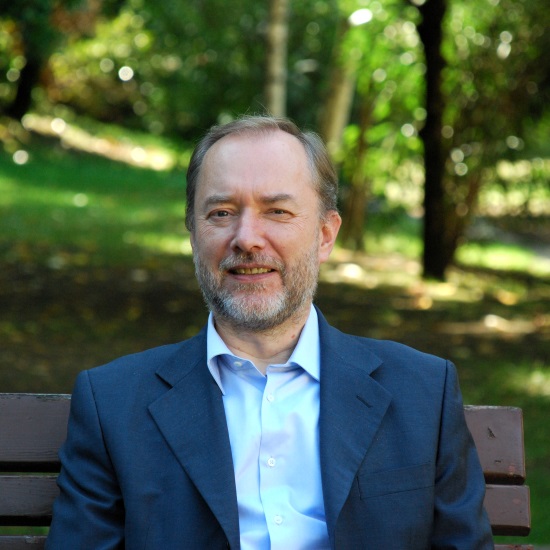
Professor Giorgio Vallortigara, University of Trento, Italy

Professor Giorgio Vallortigara, University of Trento, ItalyGiorgio Vallortigara is Professor of Neuroscience and Director of the Animal Cognition and Neuroscience Laboratory at the Centre for Mind/Brain Sciences of the University of Trento, Italy. His major research interest is the study of cognition in a comparative and evolutionary perspective, with particular reference to the mechanisms underlying the use of geometry in spatial navigation and the origins of number and object cognition in the animal brain. He also studied the evolution of the asymmetry of the brain. He discovered functional brain asymmetry in the so-called ‘lower’ vertebrate species (fish and amphibians). Professor Vallortigara’s most recent work has focused on the study of brain and cognition in insects. On all these topics he has contributed numerous articles to scientific journals and book chapters, and is the author with L.J. Rogers and R.J. Andrew of the monograph Divided Brains (Cambridge University Press, 2013). |
Chair

Professor Giorgio Vallortigara, University of Trento, Italy

Professor Giorgio Vallortigara, University of Trento, Italy
Giorgio Vallortigara is Professor of Neuroscience and Director of the Animal Cognition and Neuroscience Laboratory at the Centre for Mind/Brain Sciences of the University of Trento, Italy.
His major research interest is the study of cognition in a comparative and evolutionary perspective, with particular reference to the mechanisms underlying the use of geometry in spatial navigation and the origins of number and object cognition in the animal brain. He also studied the evolution of the asymmetry of the brain. He discovered functional brain asymmetry in the so-called ‘lower’ vertebrate species (fish and amphibians).
Professor Vallortigara’s most recent work has focused on the study of brain and cognition in insects.
On all these topics he has contributed numerous articles to scientific journals and book chapters, and is the author with L.J. Rogers and R.J. Andrew of the monograph Divided Brains (Cambridge University Press, 2013).
| 09:00 - 09:45 |
Numerical abilities of chimpanzees
This talk summarises numerical capacities in chimpanzees focusing on three topics: cardinal and ordinal aspects, decimal number system, and photographic memory for numerals. The Ai project started in 1977 when a 1-year-old female chimpanzee named Ai arrived the Primate Research Institute of Kyoto University. She mastered logico-mathematical skills including the use of Arabic numerals to label sets of items in addition to their colour and constituent objects. Next, we tested Ai on ordinal aspects of number through a sequencing task that required her to touch numerals in ascending order. These two related skills were later verified in six other chimpanzees. After introducing the numeral 0 we tested acquisition of the decimal number system from 0 to 19. A major problem for chimpanzees in these tasks was the time needed to make a judgement. Chimpanzees have a strong tendency to make quick decisions, and this led to the estimation, rather than one-by-one counting, of the items displayed. They mastered the ordinal aspect of numbers beyond 10, although two-digits numerals greater than 10 led to lower accuracy. However, the tendency for quick decisions has advantages in situations that need rapid comprehension, such as memorising numerals at a glance. Three young chimpanzees showed better performance than human adults. Eye-tracking revealed the chimpanzee-unique way of watching the world: a quick scan of the whole image, jumping from one place to the next. This contrasts with humans, who direct their gaze at specific points as they try to grasp the meaning of the image. 
Professor Tetsuro Matsuzawa, Kyoto University, Japan

Professor Tetsuro Matsuzawa, Kyoto University, JapanMatsuzawa has been studying chimpanzee both in the laboratory and in the wild. The laboratory work is known as 'Ai-project' in the Primate Research Institute of Kyoto University since 1976: a female chimpanzee named Ai learned to use Arabic numerals to represent the number (Matsuzawa, 1985, NATURE). The field work has been carried out in Bossou-Nimba, Guinea, since 1986, focusing on the tool use in the wild. Matsuzawa tries to synthesise the field and the lab work to understand the mind of chimpanzees to know the evolutionary origins of human mind. He published the books such as 'Primate origins of human cognition and behavior', 'Cognitive development in chimpanzees', 'The chimpanzees of Bossou and Nimba'. He got several prizes including Jane Goodall Award in 2001, and The Medal with Purple Ribbon in 2004, The Person of Cultural Merit in 2013. |
|
|---|---|---|
| 09:45 - 10:30 |
Brain-imaging studies of the relationship between language and mathematics
Scientists since Galileo have insisted that mathematics is structured as a language – but is this language similar to spoken language? Do mathematicians use classical language areas when doing mathematics? Converging evidence from several laboratories suggests that the left posterior superior temporal sulcus (pSTS) and inferior frontal gyrus (IFG, pars triangularis and orbitalis) play a central role in the syntax of written, spoken, or even sign language. The group used fMRI to investigate whether these brain areas also contribute to various aspects of mathematics. For the syntax of complex verbal numbers, such as ‘three hundred forty-nine’, which form a subdomain of natural language, a major contribution of the left IFG is observed. However, for the syntax of algebraic expressions such '((3+2)-4)+1', or when professional mathematicians reflect upon high-level mathematical concepts in algebra, analysis, geometry or topology, the activation spares language areas. Instead, high-level mathematics involves bilateral intraparietal areas involved in elementary number sense and simple arithmetic, and bilateral infero-temporal areas involved in processing Arabic numerals. The evidence suggests that the acquisition of mathematical concepts recycles areas involved in elementary number processing. 
Professor Stanislas Dehaene, Collège de France, France

Professor Stanislas Dehaene, Collège de France, FranceStanislas Dehaene holds the chair of Experimental Cognitive Psychology at the Collège de France in Paris. He heads the INSERM-CEA Cognitive Neuroimaging Unit, located within the NeuroSpin Center in Saclay, south of Paris – France’s advanced brain-imaging centre. His research investigates the mechanisms of human cognitive functions such as reading, calculation, and language, with a particular focus on conscious versus non-conscious processing. A member of six academies of science, he is the author of ‘The number sense’ (1997), ‘Reading in the brain’ (2009), and ‘Consciousness and the brain’ (2014). In 2014, he received the Brain Prize, together with G. Rizzolatti and T. Robbins. |
|
| 10:30 - 10:45 | Coffee | |
| 10:45 - 11:30 |
Number representations in the convergently evolved brains of primates and corvid birds
Findings in animal cognition, developmental psychology and anthropology indicate that numerical skills are rooted in non-verbal biological primitives. To decipher the neuroethological and evolutionary foundations of number representations, we study behaving monkeys and crows in combined psychophysical/neurophysiological studies. Monkeys and corvids are particularly interesting with respect to their distinguished cognitive capabilities based on independently and distinctly evolved endbrain structures. In primates, the circuitry in the six-layered neocortex endow them with high-level cognition. Interestingly, this six-layered neocortex is found to be lacking in non-mammalian vertebrates, such as birds, given that the last common ancestor of mammals and birds lived 300 Mio. years ago. Still, corvid intelligence rivals primates. Recently collected behavioural and neuronal data show an impressive correspondence of neuronal mechanisms found in the corvid brain with those described earlier in the primate brain: neurons are tuned to individual preferred numerosities, and neuronal discharges prove to be relevant for both species’ correct performance. Both the neuronal and the behavioural tuning functions are best described on a logarithmic number line, arguing for a non-linearly compressed coding of numerical information, just as predicted by the psychophysical Weber-Fecher Law. Our comparative approach suggest that this way of coding numerical information has evolved at least twice during the course of evolution, irrespective of the precise origin and anatomical structures found in intelligent vertebrate brains, based on convergent evolution. This suggests that the realised neuroethological representations constitute a superior solution to a common computational problem. 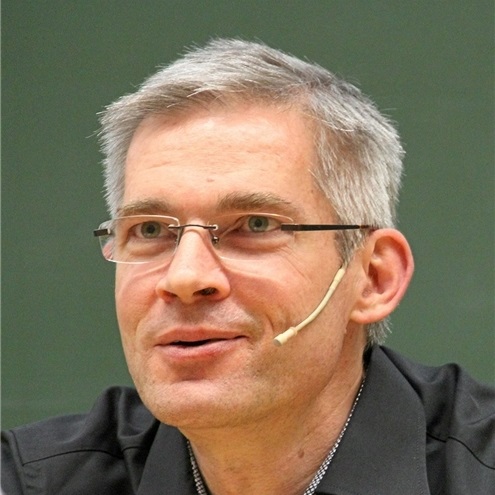
Dr Andreas Nieder, Tübingen University, Germany

Dr Andreas Nieder, Tübingen University, GermanyAndreas Nieder is professor of Animal Physiology at the Department of Biology at the University of Tübingen (Germany), where he is also Director of the Institute of Neurobiology. He studied Biology at the Technical University Munich (Germany), and received a PhD in biology/neuroscience from the University Aachen (Germany) with Dr Hermann Wagner. He was a postdoctoral fellow with Dr Earl K Miller at the Massachusetts Institute of Technology (Cambridge, Massachusetts, USA) before leading an independent junior research group at the Hertie-Institute for Clinical Brain Research/Department of Cognitive Neurology at the University Hospital Tübingen. He is interested in how higher brain centres enable intelligent, goal-directed behaviours. To that aim, his laboratory explores the functioning of highly intelligent primate and corvid brains that evolved independently through convergent evolution. |
|
| 11:30 - 12:15 |
Principle before Skill or Skill before Principle? Both
Learning to count and to find answers to addition and subtraction problems begins in infancy. Verbal and symbol re-representations build on the preverbal system for representing and reasoning about quantity. These develop without formal schooling in most cultures, especially ones with generative rules for ordered count terms that represent sequentially repeated additions. Reliance on this Natural Number system is a major and continuing obstacle to mastering more advanced externalised symbols for reasoning about quantity, that is, to learning ‘mathematics’. A startling example is the mistake that a large fraction of college students make in reasoning about oppositely directed percent changes. Although examples of these changes are omnipresent in modern culture, many students reason about them incorrectly. They process them as simple additions and subtractions, believing therefore that an X% increase is reversed by an X% decrease. Success on some problems but not many, favours a ‘skill before principle’ account of learning ‘mathematics’. 
Professor Rochel Gelman, Rutgers University, USA

Professor Rochel Gelman, Rutgers University, USARochel Gelman, Distinguished Professor of Psychology and the Rutgers Center for Cognitive Science, has a BA (University of Toronto) and a PhD (UCLA). Her work on early knowledge about number, causality, the animate-inanimate distinction and language, with infants and young children, has contributed to the domain-specific theory of learning in developmental cognitive science and later school learning about science and maths. Her honours include: membership in the USA National Academy of Sciences and the American Academy of Arts and Sciences: a Guggenheim Felllowship; designation as a William James APS Fellow; two year-long visits at the Center for Advanced Study in the Behavioral and Social Sciences; the American Psychological Associaton (APA) early and senior Contributions to Science awards: a Mentor Award (APA) and a Life-time Contribution from the Society for Research in Child Development. She also has served on many USA and international committees. |
Chair

Professor Elizabeth Brannon, University of Pennsylvania, USA

Professor Elizabeth Brannon, University of Pennsylvania, USA
Dr Elizabeth M. Brannon graduated Summa Cum Laude from The University of Pennsylvania, where she received her BA in Physical Anthropology in 1992. In 1994, she received a Masters degree in Anthropology from Columbia where she worked with Dr Marina Cords. In 2000, she completed a PhD in Psychology in the laboratory of Dr Herb Terrace. Dr Brannon was faculty at Duke University from 2000-2015 where she served as Director of Graduate Studies for the Cognitive Neuroscience Admitting Program and Head of the Developmental Training Area. She is now a Professor of Psychology at The University of Pennsylvania. Dr Brannon has received numerous academic awards and honours including the Young Investigator Award from The Society for Experimental Psychology, a CAREER award from the National Science Foundation, a Merck Scholar Award, and a James McDonnell Scholar Award. She served on the editorial board of Psychological Science, Cognition, and Infancy, served as associate editor for Developmental Science and is currently serving as an associate editor for Open Mind. Dr Brannon’s research is currently funded by The National Science Foundation and The National Institutes of Health. Dr Brannon teaches courses on cognitive development and comparative psychology and her research probes the developmental and evolutionary building blocks of human mathematical knowledge.
| 13:10 - 13:55 |
From number sense to systems of numerical notation
Establishing how numeracy has evolved in our lineage is a largely unexplored field of study. This is mainly due to the fact that archaeologists have not designed specific heuristic tools to infer numeric knowledge from past material culture. However, based on a cursory survey of the archaeological record, it can be reasonably argued that constitutive elements of number sense such as approximate representation of numerical magnitude (approximate number system), and precise representation of the quantity of few individual items (parallel individuation system), must have been already largely mastered by early hominins. Nevertheless, a threefold challenge remains, i.e., when did verbal or gestural counting systems, shared at present by all human cultures, arise in the history of humankind, when were exosomatic devices (Artifical Memory Systems, AMS), conceived and created to store, process and/or transmit numeric information, and how did they evolve to reach the symbolic systems of graphic marks that most of us uses for recording numbers. Upper Palaeolithic (40,000-10,000 years BP) archaeological sites from Europe have yielded numerous objects carrying sets of marks, incised with a variety of techniques, and interpreted as systems of notation recording numerical information. This interpretation has been proposed anew on novel theoretical and analytical grounds. On the one hand, a survey of AMSs presently in use in different human cultures individuates four distinct factors to code information: (i) the number of marks, (ii) the accumulation of marks over an extended periods of time, (iii) the spatial distribution and arrangement of the marks, and (iv) their morphology (or their different morphologies). On the other hand, it has been shown that a technological analysis of the marks, based on criteria established experimentally, is needed to interpret them as AMS, and to discard alternative functions. Recently, research on Late Upper Palaeolithic objects bearing sequential notches was conducted to test the hypothesis that these alignments comply to the Weber-Fechner law. Such compliance would entail that Upper Palaeolitic modern humans were able to distinguish between differences in magnitude of a particular stimulus, such as the difference in width between sequential notches, and the intensity of its perception. We present results obtained from the application of these two approaches to both published and unpublished objects bearing sequential markings uncovered from Lower Palaeolithic, Middle Palaeolithic, and Middle Stone Age contexts. The sample includes a notched baboon fibula from Border Cave, known as the Lebombo bone, which was interpreted as one of the earliest known evidence of numerical notation. This leads us to propose hypotheses about the mechanisms that have stimulated the transition from numerical somatosensory systems to exosomatic counting systems in some human cultures. 
Professor Francesco d'Errico, Bordeaux University, France

Professor Francesco d'Errico, Bordeaux University, FranceFrancesco d’Errico is a Director of Research with the French Centre National de la Recherche Scientifique, attached to the University of Bordeaux. A central achievement of his research has been the recognition of the most ancient symbolic traditions in Africa, Europe, the Near East, and Asia, which has enabled him to question the dominant paradigm of a sudden European origin of modern human cultures, and propose new scenarios to account for the emergence of key cultural innovations in our lineage. He is the author or editor of several books, and the author of more than 300 papers, most of which published in peer reviewed journals. He has acted as co-project leader of a large five year grant funded by the European Research Council to investigate the origin of cultural modernity in Africa and Europe. |
|
|---|---|---|
| 13:55 - 14:40 |
The deep history of counting words
English speakers use the counting word ‘two’, the French say deux, Greeks say δύο (duo), Russians say два (dva), Sanskrit speakers say dve, and Caesar would have said duo. English, French, Greek, Russian, Sanskrit and Latin are all members of the Indo-European family of languages. The various forms of the word two that all these languages use are cognate – that is, they descend from a common shared form reconstructed by linguists as duoh – spoken at the time of the origin of the Indo-European languages perhaps 6000 to 8000 years ago. By comparison, each of these languages uses a different and non-cognate form of the word bird. Professor Pagel presents evidence to show that the remarkable conservation in the Indo-European languages of a stable pairing lasting thousands of years between an otherwise arbitrary sound (two, duo, deux, and etc) and the meaning two is repeated in other language families and is typical of the deep histories of the simple counting words (taken here as the words representing ‘one’ to ‘five’). He reflects on several reasons for the conservation of counting words, including speculation about numerical abilities having a hard-wired neurological basis. 
Professor Mark Pagel FRS, University of Reading, UK

Professor Mark Pagel FRS, University of Reading, UKMark Pagel is a Fellow of the Royal Society and Professor of Evolutionary Biology at Reading University where he runs the Evolution Laboratory. He has published widely on topics in evolutionary genetics, behaviour, brain size, speciation and human culture and linguistics. He has published numerous scientific articles in the journals Nature and Science, and his research has been featured worldwide, including in The New York Times, Scientific American, National Public Radio, the Economist, Wired, and the New Scientist. He is the author of Wired for Culture: Origins of the Human Social Mind. Image: Mark Pagel at BBC Radio 3’s Free Thinking Festival. Photo credit: Dan Prince
|
|
| 14:40 - 15:25 |
Cognitive access to numbers: the philosophical significance of empirical findings about basic number abilities
We cannot see, hear, touch, taste or smell (finite cardinal) numbers; they do not emit or reflect signals; they leave no traces from which their existence and nature can be inferred. So how can we have cognitive access to them? A rapid review of the major views about the nature of numbers shows that each view faces the problem of cognitive access or is unsatisfactory for some other reason. Professor Giaquinto will try to show how we might unblock the impasse by questioning a common tacit assumption. Then he will try to indicate how, given the view he favours, the problem of cognitive access can be solved, drawing on empirical findings from the cognitive sciences. 
Professor Marcus Giaquinto, University College London, UK

Professor Marcus Giaquinto, University College London, UKMarcus Giaquinto is Professor of Philosophy (Emeritus) at University College London. He studied philosophy (BA) and then mathematical logic (MSc) in London; further study of mathematical logic at Oxford was followed by a turn to philosophy of mathematics for a doctorate. He has written two books, The Search for Certainty: a Philosophical Account of Foundations of Mathematics (OUP 2002), and Visual Thinking in Mathematics: an Epistemological Study (OUP 2007). Research for the latter was funded by a two-year British Academy readership. While teaching at UCL he had the good fortune to be guided by Professor Brian Butterworth of UCL’s Institute of Cognitive Neuroscience in learning about what was then the nascent field of numerical cognition. He is firmly convinced that the cognitive sciences are at least as important as mathematical logic for the philosophical understanding of mathematics. |
|
| 15:25 - 15:45 | Tea | |
| 15:45 - 16:20 |
The implications of an innate numerosity-processing mechanism for education
Evidence presented at this conference suggests that many species possess a mechanism for extracting numerosity from the environment. If we humans inherit a similar mechanism, this could be the foundation for our numerical competencies, rather than, as has been often claimed, reasoning, linguistic or spatial skills. Professor Butterworth will show that indeed humans possess an innate core capacity for numerosity processing. He can also show that individual differences in this capacity contribute to explaining differences in arithmetical attainment and correlated neural structures. On the basis of this, he will then go on to suggest ways in which the education of individuals should be shaped. 
Professor Brian Butterworth FBA, University College London, UK

Professor Brian Butterworth FBA, University College London, UKBrian Butterworth is in the Institute of Cognitive Neuroscience at University College London, where he is currently working on the neuroscience and the genetics of mathematical abilities and disabilities. He led two European networks, Neuromath and Numbra, that promoted multidisciplinary research on mathematical cognition. At UCL, he created the first master’s degree in cognitive neuroscience, and founded, and was first chair of, the Centre for Educational Neuroscience. He holds professorial positions at National Chengchi University, Taiwan, and at Melbourne University, Australia. He was elected Fellow of the British Psychological Society in 1993, and Fellow of the British Academy in 2002. His popular science book, The Mathematical Brain (1999) was a best seller. The Dyscalculia Screener (2003) revolutionized the identification of this specific learning disability. His latest book, co-edited with Denis Mareschal and Andrew Tolmie, Educational Neuroscience, was published by Wiley in 2013. |
|
| 16:20 - 17:00 |
Discussion, chaired by Professor Charles Gallistel
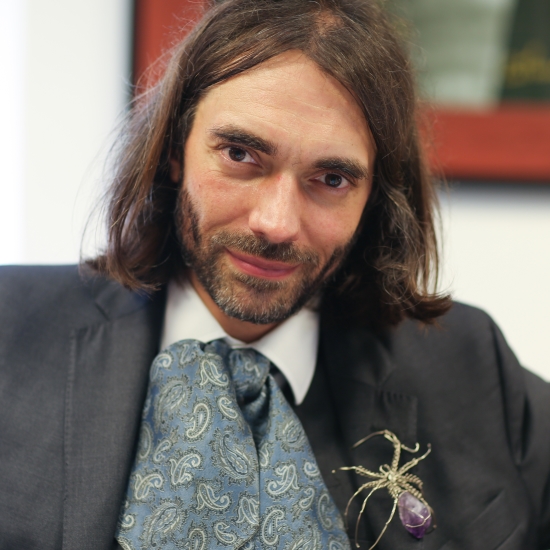
Professor Cédric Villani, Institut Henri Poincaré and Université Lyon I, France

Professor Cédric Villani, Institut Henri Poincaré and Université Lyon I, FranceCédric Villani is a mathematician, Professor at the University Claude Bernard of Lyon (from 2010), and Director of the Institut Henri Poincaré in Paris (from 2009). He taught previously at the Ecole Normale Supérieure of Lyon from 2000 to 2010, and was a visiting professor in a number of institutions, in Atlanta (1999), Berkeley (2004, 2013) and Princeton (2009). He received his PhD on the mathematical theory of the Boltzmann equation in 1998. Specialist of mathematical analysis applied to problems of statistical physics, geometry and probability, Villani has published over 50 research papers. He has also written three books, on gas theory and optimal transport theory. He is a chief editor of Journal of Functional Analysis, and editor of Inventiones Mathematicae. Villani received many national and international mathematical awards, including the Fields Medal, awarded to him in 2010. Since then he has been playing an informal role of ambassador for the french mathematical community to media (press, radio, television) and society in general. He has written books for nonspecialists, which have found a wide audience. He has also given hundreds of lectures for all kinds of audiences around the world. Villani is member of the French Academy of Sciences. Believing in the commitment of scientists in society, he is also a President of association, and a European federalist. He is a father of two. Image: Laurence Honnorat 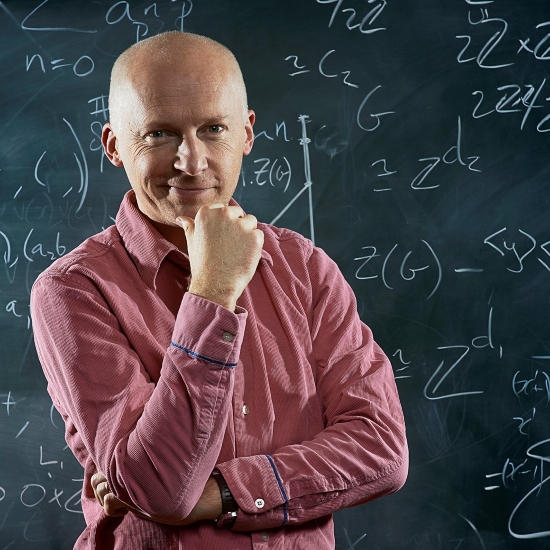
Professor Marcus du Sautoy OBE FRS, University of Oxford, UK

Professor Marcus du Sautoy OBE FRS, University of Oxford, UKMarcus du Sautoy is the Simonyi Professor for the Public Understanding of Science and Professor of Mathematics at the University of Oxford and a Fellow of the Royal Society. He is author of four popular science books including his most recent book What We Cannot Know (2016). He has presented numerous radio and TV series including a four part landmark TV series for the BBC called The Story of Maths. 
Professor Charles Gallistel, Rutgers University, USA

Professor Charles Gallistel, Rutgers University, USAC.R. Gallistel is Professor of Psychology, Emeritus and formerly Co-Director of the Rutgers Center for Cognitive Science at Rutgers. He taught previously at the University of Pennsylvania (1966-1989) and UCLA (1989-2000). He received his BA from Stanford in 1963 and his PhD in Psychology from Yale University in 1966. His research currently focuses on the development of quantitative, highly automated behavioural tests for memory malfunction in genetically manipulated mice, with the long-term goal of using genetic methods to discover the molecular, cellular and systems’ mechanisms underlying the foundational mechanisms of cognition. Other research interests are spatio-temporal learning, the theory of associative learning, the theory of action, non-verbal arithmetic in humans and non-human animals, matching behaviour, the perception of probability and electrical self-stimulation of the brain in the rat. He is a member of the American Academy of Arts and Sciences and the National Academy of Sciences. He has written several influential books. |
